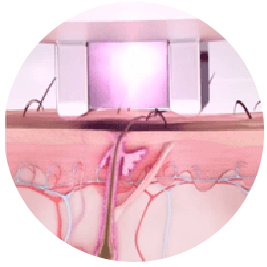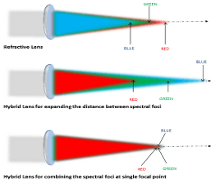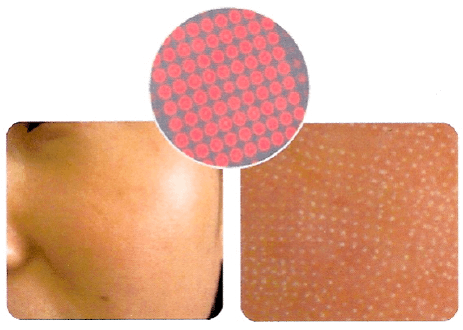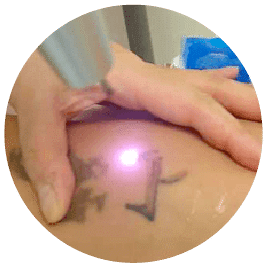INTRODUCTION
As the use of laser technology becomes a more integral tool in the field of medical & aesthetic treatments, the ability to manipulate the beam output in the laser based medical devices is increasingly important. Diffractive Optical Elements (DOE) provide a unique solution by allowing for the beam to be manipulated in a myriad of ways, and at the same time are light weight, thin and compact.
SKIN RESURFACING
Skin resurfacing includes a wide range of treatments meant to rejuvenate the appearance of the skin from imperfections caused by many factors, including acne, scarring, and excessive sun exposure. Multispot elements have proven to be effective in assisting with more efficient skin resurfacing procedures. Creating a 2D matrix of smaller laser beams covers more area of the skin than a single laser beam, thus reducing procedure time. Moreover, healing time is shorter and more effective because the laser affects the skin in an even pattern, and the uneffected skin between spots allows for a shorter migration path for epidermal stem cells to develop and rejuvenate the skin.
Relevant products: Beam splitter
Common wavelengths: 10600 nm (CO2), 2940 nm (Er:YAG)
Figure 1. A gaussian input beam split into a 9×9 array.
Figure 2. Multispot set-up.
TATTOO REMOVAL
When using a non-uniform, or gaussian, beam when performing tattoo removal, this can cause “hot spots” on the skin of the patient since such a small area is so highly concentrated with laser power. This has several disadvantages, including increased healing time, increased procedure difficulty due to overlap of the laser pulses, and longer procedure duration. Using a top-hat beam shaper or homogenizer DOE creates a uniform beam that decreases the presence of hot spots, allowing for a shorter healing time; this is thanks to the less concentrated and more uniform energy distribution on the skin. Also, a homogenizer DOE makes it easier for the technician to perform the procedure in an effective way that provides uniform treatment on the entire effected area and minimal overlap between pulses. Moreover, the duration of the procedure is shortened because the DOE provides a larger effective area on the skin than an uneven beam profile.
Relevant products: Diffuser, Top Hat
Common wavelengths: 1064 and 532 nm (Nd:YAG), 694 nm (Ruby), dependent on tattoo ink color
Figure 3. A gaussian input beam converted into a round or square homogenized spot.
Figure 4. Homogenizer set-up.
HAIR REMOVAL
Hair removal is another area of aesthetics where laser homogeneity provides a big advantage. Laser hair removal utilizes a technique called selective photothermolysis (SPTL), where targeted tissue is heated with minimal effect on adjacent tissue. The hair follicles in the target area are damaged, and the hair growth stunted. Using a non-uniform beam decreases the effectiveness of the SPTL; it becomes more difficult to know which part of the target area was affected and which was not. Also, due to the larger transfer region of a non-uniform beam, unintentional overlapping of the beam can occur, thus damaging the skin and causing uneven results. The use of a homogenizer DOE allows for a uniform beam profile which makes it easier to discern between affected regions and unaffected regions, and its narrow transfer region reduces the chance of unintentional overlapping. Additionally, the increased effected area of the beam on the skin causes a reduction in procedure time.
Relevant products: Diffuser, Top Hat
Common wavelengths: 694 nm (Ruby), 755 nm (alexandrite laser), 800 nm (diode laser), 1064 nm (Nd:YAG)

BODY CONTOURING
Laser body contouring is performed by shrinking subcutaneous fat cells with laser radiation. The use of a homogenizing DOE can assist in this treatment, and it can decrease unwanted side effects, such as skin blemishes and hyperpigmentation. By using a more uniform beam that covers a larger effected region on the body, procedure time is reduced, thus creating a more favorable experience for the patient and a more economical solution for the health care provider. Moreover, the even intensity distribution lowers the risk of burning and hyperpigmentation because the laser radiation is not so heavily concentrated in such a small area like with a regular gaussian beam.
Relevant products: Diffuser, Top Hat
Common wavelengths: 635 nm, 658 nm, 915 nm, 940 nm
SURGICAL LASERS
Laser surgery improves many surgical procedure by making them simpler and reducing risk. Laser based systems are used to preform incisions, ablation, vaporization or soldering of soft-tissue with high water content instead of traditional scalpels.The typically used wavelengths for those treatments all in the IR range and are therefore invisible to the surgeon. In order to direct the infrared beam to the correct location, an additional visible laser beam (“aiming beam”), which is coaxially superimposed on the infrared beam, is added.
Adding a DOE is a thin and elegant optical solution to correct the chromatic abberations and combine the two incident beams with different wavelengths into the same focal point on the same optical path.
Relevant products: Dual Wavelength , Diffractive F-Theta, Diffractive Achromat
Common wavelengths: 1064nm, 10600nm








